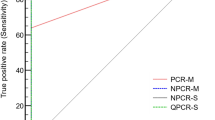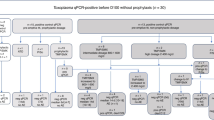Abstract
We evaluated the utility of plasma polymerase chain reaction (PCR) for surveillance of human herpes virus 6 (HHV-6) infection among pediatric bone marrow transplant (BMT) recipients. We used a prospective, non-interventional design involving a study group and controls. BMT recipients and healthy controls were evaluated. BMT subjects had HHV-6 PCR done biweekly for 12 weeks post transplantation, while a single PCR test was done on controls. For the PCR assay, EDTA blood was collected and DNA extracted from whole blood and cell-free plasma using standard procedures. The PCR was first performed on DNA from whole blood and if a positive result was obtained, the test was repeated on the DNA from the plasma. Thirty BMT recipients (13 autologous and 17 allogeneic) were enrolled, on whom a total of 156 PCR tests were performed, while six tests were done on six healthy controls. The median age of BMT subjects was 6.2 years (range 0.5–17.5 years). The median age of the control subjects was 6.6 years (range 2–10 years). Among asymptomatic BMT patients who had PCR surveillance, the positivity rate was 3.3% (1/30) on whole blood and 0% (0/30) on plasma. None of the six healthy subjects had a positive PCR test on whole blood. During the period of the surveillance study, 14 patients had diagnostic evaluations for HHV-6 disease because of clinical symptoms. Two of these patients were diagnosed with disease associated with HHV-6 (graft failure and encephalitis) and had positive PCR tests on whole blood and plasma and whole blood and cerebrospinal fluid, respectively. We conclude that despite the fact that HHV-6 seropositivity rates are high among children, the frequency of HHV-6 plasma PCR positivity is low in pediatric BMT subjects who are asymptomatic for HHV-6 disease. Given that a positive test on plasma is consistent with active infection, this increases the utility of the PCR test as a diagnostic aid in evaluating syndromes presumed to be due to HHV-6 in pediatric bone marrow transplant recipients. Bone Marrow Transplantation (2001) 28, 473–477.
This is a preview of subscription content, access via your institution
Access options
Subscribe to this journal
Receive 12 print issues and online access
$259.00 per year
only $21.58 per issue
Buy this article
- Purchase on Springer Link
- Instant access to full article PDF
Prices may be subject to local taxes which are calculated during checkout
Similar content being viewed by others
References
Rickinson AB, Kieff E . Human herpesvirus 6. In: Fields BN, Klipe DM, Howley PM et al (eds) Fields Virology 3rd edn Lippincott-Raven Publishers: Philadelphia 1996 pp 2587–2608
Yamanishi K, Okuna T, Shiraki K et al. Identification of human herpesvirus 6 as a causal agent for exanthem subitum Lancet 1988 1: 1065–1067
Salahuddin SZ, Abashi DV, Markham PD et al. Isolation of a new virus, HBLV, in patients with lymphoproliferative disorders Science 1986 234: 596–601
Braun DK, Dominguez G, Pellett PE . Human herpesvirus 6 Clin Micro Rev 1997 10: 521–567
Yoshikawa T, Suga S, Asana Y et al. A prospective study of human herpesvirus-6 infection in renal transplantation Transplantation 1992 54: 879–883
Ward KN, Gray JJ, Efstathiou S . Primary human herpesvirus 6 infection in a patient following liver transplantation from a seropositive donor J Med Virol 1989 28: 67–72
Asano Y, Yoshikawa T, Suga S et al. Reactivation of herpesvirus type 6 in children receiving bone marrow transplants for leukemia New Engl J Med 1991 324: 634–635
Yoshikawa T, Suga S, Asano Y et al. Human herpesvirus 6 in bone marrow transplantation Blood 1991 78: 1381–1384
Drobyski WR, Dunne WM, Burb EM et al. Human herpesvirus 6 (HHV-6) infection in allogeneic bone marrow transplant recipients: evidence of a marrow-suppressive role for HHV-6 in vivo J Infect Dis 1993 167: 735–739
Carigan DR, Drobyski WR, Russler SK et al. Interstitial pneumonitis associated with human herpesvirus-6 infection after marrow transplantation Lancet 1991 338: 147–149
Kadakia MP, Rybka WB, Stewart JA et al. Human herpesvirus 6: infection and disease following autologous and allogeneic bone marrow transplantation Blood 1996 87: 5341–5354
Cone RW, Huang M-L, Corey L et al. Human herpesvirus 6 infections after bone marrow transplantation: clinical and virologic manifestations J Infect Dis 1999 179: 311–318
Singh N, Carrigan DR . Human herpesvirus-6 in transplantation: an emerging pathogen Ann Intern Med 1996 124: 1065–1071
Huang LM, Kuo PF, Lee CY et al. Detection of human herpesvirus-6 DNA by polymerase chain reaction in serum or plasma J Med Virol 1992 38: 7–10
Dollard SC, Pellett PC . Human herpesviruses 6, 7 and 8 Rev Clin Microbiol 2000 11: 1–13
Secchiero P, Carrigan DR, Asano Y et al. Detection of human herpesvirus 6 in plasma of children with primary infection and immunosuppressed patients by polymerase chain reaction J Infect Dis 1995 171: 273–280
Johnson G, Nelson S, Petric M, Tellier R . A comprehensive PCR-based assay for the detection and speciation of human herpesviruses J Clin Microbiol 2000 38: 3272–3279
Cone RW, Huang ML, Ashley R, Corey L . HHV-6 DNA in peripheral blood cells and saliva from immunocompetent individuals J Clin Microbiol 1993 31: 1262–1267
Chou S, Scott KM . Rises in antibody to human herpesvirus 6 detected by enzyme immunoassay in transplant recipients with primary cytomegalovirus infection J Clin Microbiol 1990 28: 851–854
Carrigan DR . Human herpesvirus after bone marrow transplantation In: Ablashi DV, Krueger GR, Salahuddin DZ (eds) Human Herpesvirus-6: Epidemiology, Molecular Biology, and Clinical Pathology Elsevier: New York 1992 pp 281–301
Wilson A, Sharp M, Koropchak CM et al. Subclinical varicella-zoster viremia, herpes zoster, and T lymphocyte immunity to varicella-zoster viral antigens after bone marrow transplantation J Infect Dis 1992 165: 119–126
Rogers SY, Irving W, Harris A, Russel NH . Visceral varicella zoster infection after bone marrow transplantation without skin involvement and the use of PCR for diagnosis BoneMarrow Transplant 1995 15: 805–807
Acknowledgements
This paper was presented in part at the 2000 Pediatric Academic Societies meeting, Boston, MA. This work was funded in part by an internal peer-reviewed grant from Pediatric Consultants, The Hospital for Sick Children, Toronto. We would like to thank Grant Johnson and Sumita Flemming for technical assistance with the PCR assay and HHV-6 serology testing, respectively.
Author information
Authors and Affiliations
Rights and permissions
About this article
Cite this article
Allen, U., Tellier, R., Doyle, J. et al. The utility of plasma polymerase chain reaction for human herpes virus-6 among pediatric bone marrow transplant recipients: results of a pilot study. Bone Marrow Transplant 28, 473–477 (2001). https://doi.org/10.1038/sj.bmt.1703153
Received:
Accepted:
Published:
Issue Date:
DOI: https://doi.org/10.1038/sj.bmt.1703153



